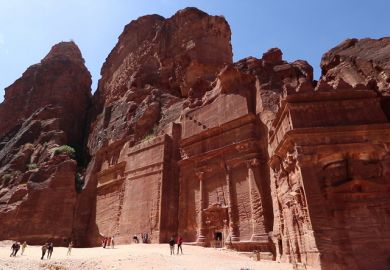Mexico is an archaeological wonderland. In the pre-Columbian past, it was part of Mesoamerica - a cultural area whose boundaries encompassed modern Guatemala, Honduras and Belize. The distinctive traits shared by such great Mesoamerican civilisations as the Zapotec, Teotihuacán, Maya and Aztec included hieroglyphic and pictographic writing, the ritual ball game,monumental architecture and an ingenious dual-calendar system. Over the past 30 years, modern archaeology has uncovered ever more startling evidence of Mesoamerica's cultural sophistication - a wealth of information and insight now being published for the general reader in a variety of ways.
It is not often that glossy coffee-table books have something to say about Mesoamerica's rich archaeological heritage. In Ancient West Mexico: Art and Archaeology of the Unknown Past , Richard Townsend achieves this rare goal. By drawing together a fascinating collection of expert essays, this lavishly illustrated book explores the art styles and cultures of a region that is little known beyond academic and art collecting circles.
West Mexico is a spectacular place - a mosaic of low-lying marshlands, lakes, snow-covered mountains and pine and oak forests. Its ancient peoples participated in the wider Mesoamerican sphere, although they possessed distinctive features of their own. Across the modern states of Jalisco, Colima and Nayarit, prehistoric societies flourished for a thousand years between c. 200 BC and c. AD 800. In subterranean tombs they deposited a physical and metaphorical universe of images that drew on a typically Amerindian world view for their inspiration. It is a mark of progress in Mesoamerican archaeology that an area once seen as a cultural backwater is now recognised as a vital part of the region's prehistoric heritage.
In an eloquent introduction, Townsend sketches the background. The first mention of west Mexico's archaeology was made by the intrepid British traveller Adela Breton, who visited the area in 1895, sketching and purchasing antiquities near Etzatlán in Jalisco. A short time later, the Norwegian anthropologist Carl Lumholtz arrived during a long sojourn studying the tribes of northwest Mexico. Despite these trail-blazing expeditions, it was not until the 1920s, in the wake of Mexico's revolution, that Mexican artists began collecting their country's pre-Columbian past - especially the lively naturalistic earthenware figures from west Mexico. The first archaeological explorations were carried out in the 1930s, and were followed in 1946 by an exhibition in Mexico City. It was around this time that the anthropologist Paul Kirchoff presciently noted the similarities between the west Mexican figurines and those from Ecuador and Colombia in South America. However, the region's lack of ancient cities, pyramids or recognisable gods, which characterised the more famous civilisations, created the impression of isolated unsophisticated cultures on the periphery of Mesoamerica.
This view persisted into the 1970s, even as it became obvious that the region's pre-Columbian peoples had produced a host of dazzling art styles. These included hollow figurines with exaggerated expressions and brightly coloured clothing, together with clay models of ceremonial palaces and ritual scenes from Ixtlán del Río and introspective figures with polychrome mask-like faces known as "Chinescos" from San Pedro Lagunillas - both in Nayarit. In Colima, the Comala tradition featured burnished ceramic figures of shamans, musicians, women and acrobats as well as birds,dogs and armadillos. Significantly, between c. 200 BC and c. AD 200, different styles of pottery turn up in the same tomb, suggesting favoured designs, trade and an increasing religious and political cohesion in the area. However, virtually all such finds came from looted tombs.
As the decade progressed, investigations in Jalisco indicated an in situ development of social complexity revealed by a hierarchy of large settlements, circular enclosures, shaft tombs and obsidian workshops. This picture of cultural sophistication was reinforced in 1993 with the excavation of an unlooted shaft tomb at Huitzilapa that contained multiple high-status burials dated to about AD 200. The bodies were covered with textiles, shell jewellry and obsidian, and were accompanied by ceramic figures - indicating their status as members of a local aristocracy associated with ancestors and fertility rituals. Analysis of the skeletal remains suggests two of the males were warriors and perhaps ball players.
Particularly revealing of the symbolic world of the region's prehistoric inhabitants is the analysis of pottery figures and scenes that seem to depict ritual feasting, where community leaders may have vied with each other through the accumulation and redistribution of food. Such activities appear in ceramic models that show groups of figures singing, dancing and embracing in houses and pavilions. On the larger scale is an appraisal of the symbolic organisation of ceremonial sites, which posits links between architecture, astronomical events and climatic phenomena in an integrated fashion so common elsewhere in the Americas. Linked to the known cosmic associations of the pan-Mesoamerican ritual ball game are the ball courts that have been found - both as physical features of the area's sites and as ceramic miniature models in tombs.
West Mexico's figurines are a distinctive part of its material culture. From an ethnographic perspective, so-called horned-warrior figurines are interpreted as shamans fighting malevolent spirits rather than human opponents. A different view suggests that where such figures are associated with conch shells they are part of a ritual iconography of rulership linked to shamanic concepts of fertility. Especially stimulating is a discussion of the indigenous landscape, its flora and fauna, and attempts to correlate these with archaeological settlement data, thereby reconstructing the pre-Columbian diet and human relationships with the natural world. Picking up on Kirchoff's earlier ideas of seaborne influences is an analysis of the clothing and adornments of tomb figures in the light of similar styles and objects emanating from Ecuador. This idea is inspired partly by the early arrival in west Mexico of metalworking traditions from South America around AD 700.
The book ends with a flourish, by exploring the influence of the region's pre-Columbian art masterpieces on such major 20th-century artists as Diego Rivera, Frida Kahlo and Henry Moore. The wealth of images here links the past to the present in a self-reflective way well suited to the increasingly multi-disciplinary nature of modern archaeology.
A different but complementary approach to exploring Mesoamerica's past is adopted by Richard Blanton and his collaborators in Ancient Oaxaca . This small and tightly written volume focuses on one area, charting the rise of civilisation in the Valley of Oaxaca in southern Mexico. A good example of a scholarly yet accessible introductory book, it distils the essential points from more than 30 years of archaeological research (and innumerable scholarly monographs) in the three valleys that comprise the Oaxaca valley system.
The authors reveal trends towards a complex society based on increasing sophistication of agriculture and the appearance between 1400 and 1150 BC of a precocious village known as San José Mogote. Female figurines and public architecture signalled the beginnings of a distinctively Oaxacan culture based on exchange and trade with other parts of Mesoamerica. Between 700 and 500 BC, the population increased dramatically and inter-village conflict increased. Hieroglyphic writing appeared for the first time, and the decision was taken to move the valley's scattered rural population to a centrally located hilltop and build the great Zapotec city of Monte Albán.
The city's rulers brought the region under unified control, employing the labour force to build canals, terraces and outlying centres, and to construct the elaborate public architecture at Monte Albán. The city's population rose to about 20,000, and by AD 200 the Zapotecs had achieved statehood, maintaining diplomatic relations with the huge city of Teotihuacán.
* in central Mexico. These developments are revealed in the elaboration of a rain-lightning-fertility cult centred on pottery images of the god Cocijo, and in more mundane changes in household goods and activities.
Together, these two books reveal the vibrancy of Mesoamerican archaeology.In different styles, each offers fascinating insights into the nature of ancient Mesoamerica and shows how specialist knowledge can be presented to a wider public.
Nicholas Saunders is British Academy institutional fellow in anthropology,University College London.
Ancient West Mexico: Art and Archaeology of the Unknown Past
Editor - Richard F. Townsend
ISBN - 0 500 05092 9
Publisher - Thames and Hudson
Price - £35.00
Pages - 308
Register to continue
Why register?
- Registration is free and only takes a moment
- Once registered, you can read 3 articles a month
- Sign up for our newsletter
Subscribe
Or subscribe for unlimited access to:
- Unlimited access to news, views, insights & reviews
- Digital editions
- Digital access to THE’s university and college rankings analysis
Already registered or a current subscriber? Login



